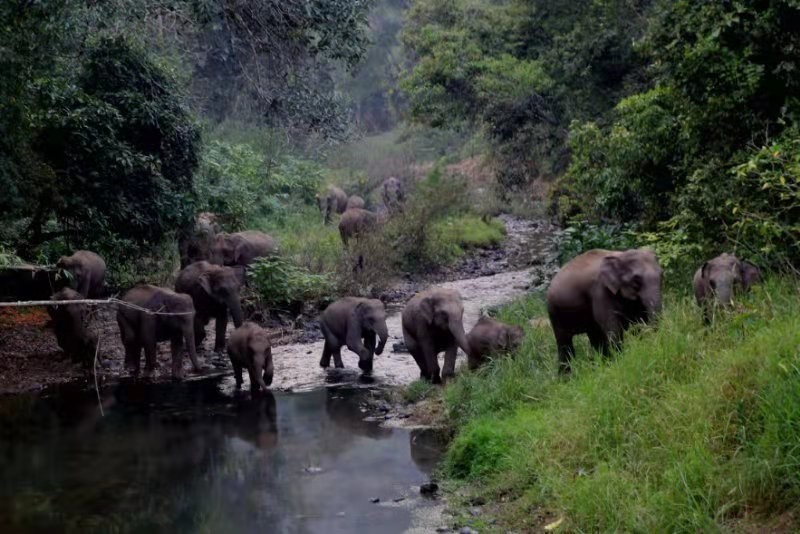China protects biodiversity with determination
On the vast land of China, the beauty of biodiversity can be found everywhere. The northward migration of wild Asian elephants in southwest China's Yunnan province, the frequent appearances of the Yangtze finless porpoises, the presence of marbled cats (Pardofelis Marmorata) in the Gaoligong Mountain National Nature Reserve in Yunnan, and the spectacular view of thousands of Tibetan antelopes galloping on the Qinghai-Tibet Plateau, etc, show that China's remarkable progress in biodiversity conservation.
This year marks the 30th anniversary of the adoption of the Convention on Biological Diversity. As one of the earliest parties to sign and ratify the Convention, China has always been taking various measures to protect biodiversity.
China attaches great importance to biodiversity protection. It has elevated biodiversity conservation to a national strategy, taken a series of measures to protect biodiversity, and constantly improved the systems, mechanisms, and policies concerning biodiversity protection.

Fifteen wild Asian elephants embark on an adventure in the summer of 2021 in southwest China's Yunnan province, making global headlines. (Photo courtesy of the Asian elephant work steering group under the National Forestry and Grassland Administration)
In 2011, the China National Committee for Biodiversity Conservation (CNCBC) was unveiled to coordinate biodiversity protection efforts nationwide and provided guidance for China's Action on United Nations Decade on Biodiversity. China also released and implemented a national action plan as well as 22 protection strategies and action plans at the local level.
Over the past nearly 10 years, China has promulgated and revised more than 20 laws and regulations related to biodiversity conservation, including the Forestry Law and the Grassland Law. In 2021, China released the Opinions on Further Strengthening Biodiversity Conservation and made it a programmatic plan in the country's biodiversity conservation work.
A document released by the Supreme People's Court, China's top court, showed that since 2013, courts at various levels across the country have handled 182,000 biodiversity cases involving rare and endangered animals and plants, including Chinese sturgeon, Tibetan antelopes, Taxus chinensis, and other representative and endemic species in China, as well as pangolins, great white sharks, coral, and other globally rare and endangered species, offering a law-based biodiversity conservation approach with Chinese characteristics.
China has introduced ecological red lines, which have demarcated over 30 percent of its land area as protected, covering all ecological areas, areas which are ecologically vulnerable, and key biodiversity distribution areas. A total of 90 percent of the country's terrestrial ecosystem types and 74 percent of key state-protected wild flora and fauna species have been placed under effective protection measures. The country has established 749 observation plots and completed an assessment of higher plants, vertebrates, and macrofungi species.

Yangtze finless porpoises frolic in the waters of Gezhouba Dam in Yichang, central China's Hubei province, Aug. 12, 2022. (People's Daily Online/Wang Gang)
In October 2021, the first part of the 15th meeting of the Conference of the Parties to the UN Convention on Biological Diversity (COP15) was held in Kunming, the capital of Yunnan province.
"Over the past year, China has made new headway in mainstreaming biodiversity conservation. The country launched the first batch of national parks, which cover nearly 30 percent of the key terrestrial wildlife species found in China. The country also inaugurated and opened the China National Botanical Garden in Beijing and the South China National Botanical Garden in Guangzhou, kicking off the construction of the national botanical garden system," said Cui Shuhong, director-general of the Department of Nature and Ecology Conservation at the Ministry of Ecology and Environment.
In recent years, China has carried out cooperation on biodiversity conservation with many countries, and the cooperation has yielded fruitful results. The China-Laos transboundary biodiversity reserve, with an area of 200,000 hectares, effectively protects rare and endangered species such as Asian elephants and their habitats. The Sino-Africa Joint Research Center under the Chinese Academy of Sciences has cultivated more than 200 postgraduate students from Africa on biodiversity conservation and utilization, building a talent pool for African countries.
In terms of foreign investment and cooperation, the Chinese government has always adhered to a green development philosophy. Relevant departments have jointly issued and implemented policy documents, including the Opinions on the Joint Implementation of Green Development in the Belt and Road Initiative, which set clear-cut requirements for environmental protection in the implementation of relevant projects.

Wild animals pass through a passage built under the Mombasa-Nairobi Standard Gauge Railway (SGR) in Kenya. A total of 14 large wildlife passages have been set up along the entire railway in consideration of the living habits of wild animals. (Photo courtesy of the China Communications Construction)
In building the Mombasa-Nairobi Standard Gauge Railway (SGR) in Kenya, Chinese builders set up passages, bridges, and culverts for large wild animals to freely and safely pass under the railway. During the construction of Ghana's new container terminal, Chinese builders established a sea turtle hatchery and released baby turtles into the ocean. These projects have not only promoted local economic development but also protected biodiversity.
The second part of the COP15 is being held from December 7 to 19 in Montreal, Canada. As the presidency of the COP15, China has fully performed its duties and promoted communication and coordination among various parties in a multi-facet, multi-dimensional, and multi-level manner, actively advancing the process of consultations and negotiations on the Post-2020 Global Biodiversity Framework.
Biodiversity is the basis for human survival and development and has a direct bearing on our wellbeing. Going forward, China will continue to advance ecological progress, and plan its development in the context of promoting harmonious co-existence between man and Nature.
Photos
Related Stories
Copyright © 2022 People's Daily Online. All Rights Reserved.









